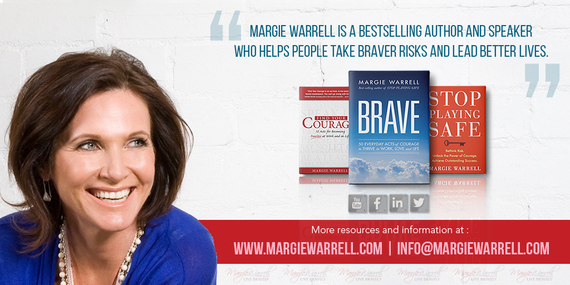Change isn't easy. Even change for the better. Great leaders know that and don't pretend otherwise. Here's ten ways you can help navigate your team and organization through uncharted waters.
Lead from "Why"
One of the main reasons change programs fail is because people don't understand why they're being put through the ringer, which is why leaders must be clear about the big "why" driving change and able to articulate it in an accessible relevant way. A leader who can't explain to people why they must change what they've been doing will only deepen any entrenched cynicism and add fuel to disenchantment.
So help people understand the larger context and what lies at stake if they don't change. Make sure they don't feel like they are going through a whole lot of pain, uncertainty and hard work for no good reason. Don't assume they understand the bigger picture. They don't. Help them see how their role, and the changes being made to it, makes sense with the larger strategy being executed.
Risk over-communication
People need to hear from you often. More often than you might think and more often than you may feel you have time for. So walk the corridors, be visible and be sure you are regularly communicating what's going on via various channels. Likewise set clear directions for the future, specific role expectations and never assume that something is "obvious" when you're moving through change. It may be obvious to you, but not to the folks in the front line.
Leverage emotional contagion
Organizational psychologists have found that each workplace develops its own group emotion, or "group effective tone", which over time creates shared "emotional norms" that are proliferated and reinforced by behavior, both verbal and non verbal. But it can also work for the positive.
Leaders act as an emotional barometer as people look to them for cues on how to think and behave, particular when uncertain. That is, act in ways that help people become:
- More focused, less overwhelmed
- More adaptable, less rigid
- More decisive, less hesitant and more optimistic
- Less concerned about when the sky might fall in
Make it safe, protect your people
No one enjoys making a mistake. However unless people feel they're able to make the odd bad decision, they won't be willing to risk making good ones.
Leaders need to create a psychological safety net that will catch people when they don't make a perfect landing. Reassuring people that their risks won't be punished -- assuming they're doing their homework and not being reckless or foolhardy -- helps to offset their fear and fosters the curiosity and creativity needed to forge new ground in more innovative ways. By focusing solely on the consequences of failure, such managers are, in effect, widening the holes in the safety nets.
Acknowledge anxiety - (spoken and silent!)
Great leaders don't pretend that everything is perfect or that the uncertainty change creates is easy sailing. Rather they help people put their fears into perspective, and focus their attention on what is in their control, not on what isn't. By tuning into unspoken concerns and acknowledging the fears of those around them, they can help people navigate their way through change with greater calm and confidence. Sure, the future is uncertain but "we'll get through this and I've got your back."
Encourage smart risks
People are wired toward caution. When making decisions, we have an innate tendency to overestimate the probability of failure, to underestimate ourselves (particularly women!) and to downplay the cost of inaction, amplifying the short-term consequences of taking action over longer-term risks of inaction. As Daniel Kahneman wrote in Thinking, Fast and Slow, "losses loom larger than gains." That thinking can keep us safe in the short term, but the more attention placed on what might go wrong, the less we have left for what could go right.
Leaders can help to counter "loss aversion bias" by helping people "rethink the risks" and refocus on the possibilities those risks opens up. In a "culture of courage", a risk gone awry isn't a career-ender. Rather failure is regarded as a valuable teacher providing critical lessons on how to do better moving.
" target="_hplink">
Bill Marriott, who grew the Marriott hotel empire from a small motel and is now Chairman of Marriott International, share with me that leaders can't get too comfortable with their success. "You've got to take risks or you'll end up going backward," he shared in a recent interview (an edited clip above). Leaders therefore need to get people to continually reflect on the same three questions they are always asking themselves:
- What's the worst that could happen?
- What would I do if the worst did happen?
- What can happen if I do nothing?
Nudge people into discomfort
When trained in how to disarm highly explosive bombs and given sufficient practice at it, bomb disposal experts are able to calmly handle situations that would paralyze many in terror. It's because the more often people are exposed to situations outside their comfort zone, the more comfortable they get with them. Coined the "Mere Exposure Effect," it explains why it's so crucial to sometimes give people a gentle (or not so gentle) nudge out of their comfort zone. Each time they leave it, it builds an emotional scaffolding to bolster their confidence for bigger challenges in the future. For instance, asking someone to assist in preparing and co-presenting a few times before they take on the lead role will set them up for success when they take the lead.
People build confidence in increments.
Appoint "Change Ambassadors"
Let's face it, those who set the strategy at the top are often far removed from the "pain points" of those further down the organizational hierarchy left to execute and deal with the front line challenges change creates. Engaging people right down through your organization to "wave the flag" and influence the outlook of those in the trenches. They will be able to set the "group effective tone" far more powerfully when the going gets tough than anyone sitting up in the c-suite.
Reward brave behavior; not just results
Let's face it, when forging new ground not every step will move you forward. Which is why it's vital to acknowledge people when they act bravely -- whether speaking up in a meeting to challenge the consensus or experimenting with a new approach -- even when their actions don't produce the outcome they want.
The reward doesn't have to be a trophy or a bonus; it could simply be a handwritten note from a manager, a few encouraging words or acknowledgment in front of peers at a team meeting. The type of reward doesn't matter so long as it's meaningful to the person receiving. As I wrote in Stop Playing Safe, "When you reward courageous behaviors -- not just successful ones -- you're reinforcing the mind set you want them to embrace." After all, while courage doesn't guarantee success, it always precedes it.
While courage doesn't guarantee success, it always precedes it.
Lead by example: risk your own safety.
The extent to which those around you will be willing to act courageously is determined by how much you are. Leaders who are willing to lay their own reputation, security and safety on the line for the sake of something more important will grow influence where others grow anxiety. So take a moment to consider where you need to put the purpose of your organization ahead of your pride. If you're not forging new ground in how you lead yourself, then you most certainly won't be able to lead others to forge new ground in your organization.
Your willingness to be decisive amid the uncertainty and take a risk will have far more potent impact on the people and success of your organization than any other single factor. Never underestimate the power of your everyday example: it speaks far more loudly than your words ever can.
___________________________________


